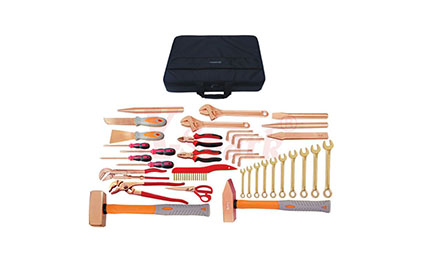On November 22, 2013, an oil pipeline of a company located in Qingdao ruptured. During the disposal process, on-site workers used hydraulic breakers to punch holes on the cover of the culvert, resulting in impact sparks that caused an explosion of oil and gas in the culvert. A deflagration occurred on the surface of the sea contaminated by oil.
On September 15, 2019, a fire accident occurred in the oxidation workshop of an enterprise in Shandong Province. After a preliminary inspection, the cause of the accident was that the employees on duty used non-explosion-proof tools to discharge materials, and sparks were generated when they encountered iron receiving trays; at the same time, horizontal screw unloading During the operation of the centrifuge, air, and toluene vapor are mixed to form explosive gas, which leaks through the discharge port, encounters sparks, and deflagrates!
Ordinary tool materials are usually made of steel materials. Sparks will be generated due to friction and impact during use. The main reason is that steel materials contain more carbon (in order to increase their strength and hardness). The heat cannot be absorbed and conducted in time, and sparks will be generated when the heat is concentrated on the tiny metal particles generated during use. Therefore, these tools cannot be used in explosion-dangerous places.
The tools used in explosion-hazardous places must be made of special materials that do not produce frictional sparks, impact sparks, or even hot, high-temperature surfaces. Such tools are called explosion-proof tools. The main material of explosion-proof tools is copper. Copper contains almost no carbon and has very good thermal conductivity. Due to its soft material, when friction or impact occurs, the contact point will be plastically deformed to avoid excessive energy concentration and rapid heat generation. Disperse and reduce the risk of intense heat. However, the strength and hardness of pure copper are too low to be directly used as tools. It is necessary to add appropriate metal elements such as aluminum, titanium, beryllium, nickel, etc. to melt into copper alloys to improve its strength and hardness.

Explosion Proof Hand Tools
According to the different material components, the explosion-proof tools are mainly divided into two categories: 1. Aluminum-copper alloy (commonly known as aluminum bronze) explosion-proof tools, the specific material is high-purity electrolytic copper as the matrix and appropriate amounts of aluminum, nickel, manganese, iron and other metals. Form a copper-based alloy. 2. Beryllium bronze alloy (commonly known as beryllium bronze) explosion-proof tools, the specific material is high-purity electrolytic copper as the matrix, adding appropriate amounts of beryllium, nickel, and other metals to form a copper-based alloy. The thermal and electrical conductivity of these two materials is very good.
According to the manufacturing process of explosion-proof tools, it can be divided into two categories: 1. Casting process: It is a traditional manufacturing process and is widely used by most domestic explosion-proof tool manufacturers. Advantages of the casting process: simple process and low manufacturing cost. Disadvantages: low product density, hardness, tensile strength, and torque, and more pores and trachoma lead to shorter product life. 2. Forging process: It is made by one-time forging and pressing with a large press or punching machine and a high heat-resistant forming die. The advantages of the forging process: the product density, hardness, tensile strength, and torsion are greatly improved, pores and trachoma are basically eliminated, and the service life of the mechanical properties of the product is about twice as long as the traditional casting process. Disadvantages: large investment in production equipment and molds, resulting in high costs.
1. Percussion tool products, the surface attachments of the tool should be treated after 20 consecutive taps in daily work, and then used after cleaning. Do not use continuously, lest the tool will be exposed to friction for a long time Heated.
2. Wrench products should not be used excessively, and should not be used to extend the moment arm with a casing or binding other metal rods and to use a hammer to knock (except for the knocking of a wrench) to turn fasteners.
3. After use, clean the dirt and deposits on the surface and store it in a dry and safe place.
4. Cutting edge tools should be placed in the sink and lightly touch the grinding wheel for sharpening. Do not use excessive force and contact the grinding wheel for too long.